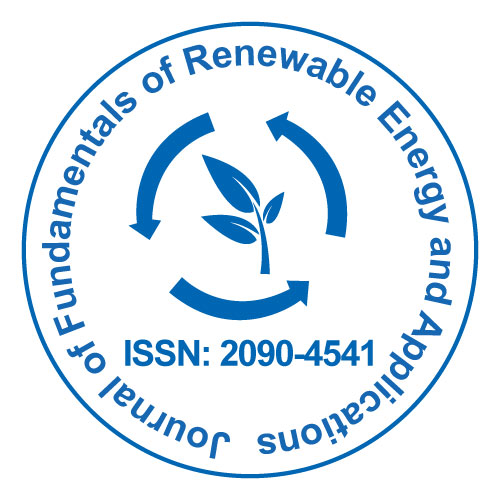
Journal of Fundamentals of Renewable Energy and Applications
Open Access
ISSN: 2090-4541

ISSN: 2090-4541
Mistry Khyati
Pandit Deendayal Energy University, India
Scientific Tracks Abstracts: J Fundam Renewable Energy Appl
Electrocatalysts that are efficient are required to promote the hydrogen evolution process (HER). Existing electrocatalysts are restricted by slow HER kinetics, increased over potential resulting in higher energy requirement, instability over time, and impurity tolerance. In the authors' prior research, these limitations resulted in a lower solar-to-hydrogen conversion efficiency of 2.46% utilising MoS2 electrocatalyst. Because of their high surface area, outstanding catalytic activity, and durability in acidic and alkaline conditions, mixed metal oxide/conducting polymer nanocomposites have showed considerable promise for application in hydrogen evolution reaction (HER) reactors. A appropriate electrocatalyst must have a low overpotential for hydrogen evolution, a high tolerance to contaminants, and long-term durability to be more efficient than typical electrocatalysts. With this background in mind, the current study focuses on the use of a CuO/TiO2/Polyindole (CTPIN) nanocomposite synthesised in two steps using microemulsion and oxidative polymerization processes. Various physicochemical approaches were used to characterise the final substance. HRTEM investigation clearly shows the development of CTPIN nanocatalysts with ultrasmall particle sizes ranging from 10 to 30 nm. The nickel strip coated with CTPIN nanoparticles served as the cathode for solar hydrogen generation via membraneless electrochemical water splitting. Membraneless electrolyzers, which enable efficient electrochemical hydrogen production, are a potential and cost-effective alternative to standard electrolyzers. Under typical operating circumstances and at a radiation intensity of 320 W/m2, the CTPIN nanocomposite displayed a solar-to-hydrogen production efficiency of 3.43%, which is higher than prior values reported using MoS2.The CTPIN electrocatalyst shows great promise for electrocatalytic solar hydrogen production. The CTPIN electrocatalyst may enable the production of hydrogen from a clean and sustainable energy source. Keywords: Electrocatalysis, Reverse micelle microemulsion technique, Polyindole, Hydrogen evolution reaction, Solar hydrogen generation
Ms. Khyati Mistry is pursuing a Ph.D. at PDEU, Gandhinagar. Before joining Ph.D. Ms. Khyati Mistry has worked as an Executive at Torrent Pharmaceutical LTD India. Currently working in the area of heterogeneous catalysis and sensing for food colors. She has 7 publications in reputed journals in the three years of research work in her Ph.D. One Indian patent has been filed for novel material. She is awarded the “Dr. Sarvepalli Radhakrishnan Young Researcher Award 2023” by the Government of Andra Pradesh.